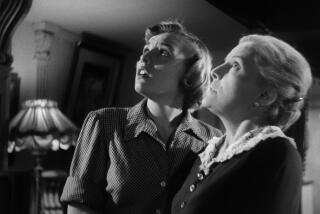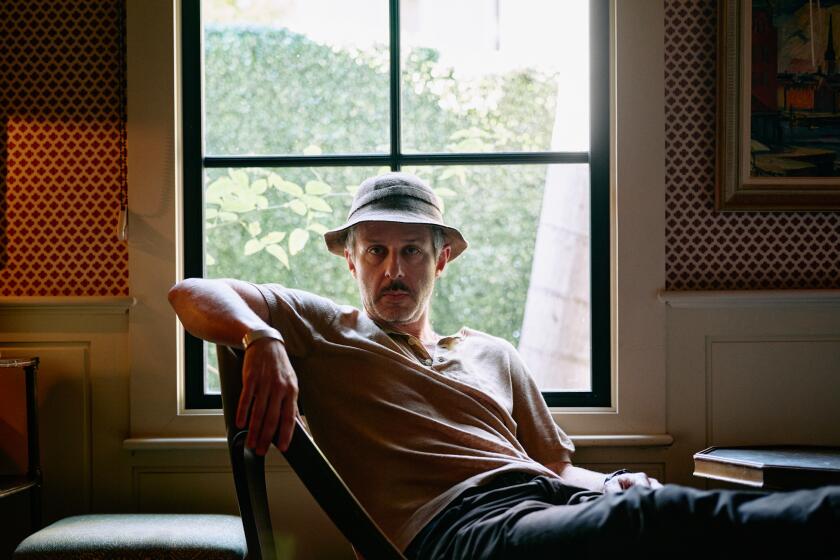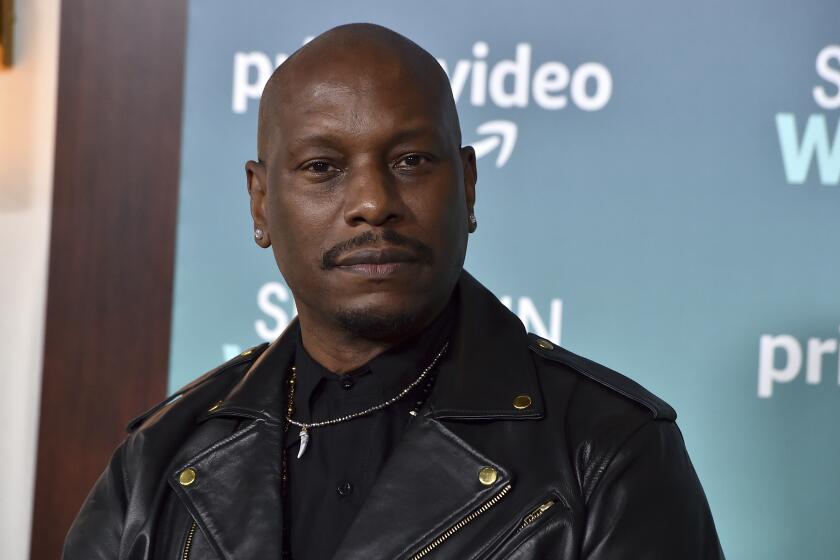Revisiting the Dawn of Avant-Garde Films
It will come as a surprise to many film aficionados that the filmmakers included in “Unseen Cinema: Early American Avant-Garde Film, 1893-1941” include Frank Capra, Busby Berkeley, D.W. Griffith, Edwin S. Porter and Orson Welles.
Curated by film historian Bruce Posner, the traveling exhibition being presented by the UCLA Film & Television Archive begins today at the university’s Melnitz Hall and continues through Feb. 24.
For decades the party line regarding avant-garde filmmaking in America was that Maya Deren gave birth to the genre in 1943. But that conception has changed over the past decade. “Unseen Cinema” illustrates the various types of avant-garde films made prior to Deren’s.
Between 1893 and 1913, filmmakers frequently experimented with content and even methods of production. The years from 1926 to 1929 were golden for the avant-garde, which saw impressive experimental work from such filmmakers as Slavko Vorkapich, Robert Florey, Ralph Steiner and Robert Flaherty. During the Depression, amateur filmmakers flourished, and professional directors explored social issues in ways that would seem almost unfathomable today.
Jan-Christopher Horak, the curator of the Hollywood Entertainment Museum and a professor of film at UCLA, has written several books on avant-garde cinema including “Lovers of Cinema: The First American Film Avant-Garde 1919-1945.” He says perceptions of avant-garde cinema have changed among historians because more material has become accessible. “Much of the material [in the exhibition] was not accessible 15 or 20 years ago. It is really to Bruce’s credit that he managed to get viewing prints [from the major film archives] for this traveling show.”
The majority of films in the exhibit had long been forgotten, says Posner. “Like Edwin S. Porter’s ‘Jack and the Beanstalk.’ He went on to make ‘The Great Train Robbery,’ which almost everybody knows, but they don’t know he produced several hundred other films. These were trained artists and craftspeople. But because time has buried them, we don’t know this. In the last 10 years or so, these films are finally starting to get out of the museums and archives and collections. It changes the whole notion of what went on back then, from one of primitive filmmaking to outstanding visual artists who are just as strong as people from post-1941.”
The only feature-length movie in the exhibit is 1922’s “Salome,” starring Nazimova. Directed by Charles Bryant, the film featured the exotic sets and costumes of Natacha Rambova--who later married Rudolph Valentino--that were based on Aubrey Beardsley’s designs for the 1905 opera based on Oscar Wilde’s 1894 one-act play. The film is a wallow in high camp and excess, but it is also gorgeous to behold.
“Salome” screens tonight in a program that includes Frank Capra’s first film, 1921’s “Fultah Fisher’s Boarding House” and Florey and Vorkapich’s seminal 1927 short, “The Life and Death of 9413--A Hollywood Extra.”
“‘Salome’ is an amazing film,” says Posner. “It was a huge, colossal flop. [Nazimova] sunk her money into it. It was truly an independent production. She was one of the biggest stars. When she came to Hollywood she made 19 films.”
With “Salome,” he said, “she went over the top.”
Much of the criticism when “Salome” was released focused on the fact that the 43-year-old actress was a bit too long in the tooth to play a 14-year-old temptress. “But when you see it on the screen, her eyes--the way they were photographed--are startling,” says Posner. “It carries the film.”
*
Seven years before he directed his 1941 masterwork, “Citizen Kane,” a then-19-year-old Orson Welles and a high school buddy William Vance made the eight-minute expressionist silent “The Hearts of Age,” which screens Feb. 24.
Vance and Welles had been students at a private high school outside Chicago. “There was a man there named Roger Hill who ran the theater program,” says Posner. “He was encouraging people to make movies, and he got them a camera. Welles graduated, and the next summer he came back --there was a theater festival for the weekend--and they shot this little spoof playing off of ‘The Cabinet of Dr. Caligari’ [the 1919 classic German expressionistic thriller] that was really popular at the time and ‘Blood of the Poet’ [Jean Cocteau’s avant-garde 1930 French film].
“Welles did an interview [once] with Peter Bogdanovich, and he said, ‘It was just Sunday afternoon fun. It’s just nothing.’ But the film is so complex and has everything Orson Welles [did in subsequent movies]--you have fast cutting, disorientation.”
Horak will introduce the Feb. 23 program that includes one of his favorite films, Charles Sheeler and Paul Strand’s “Manhatta (New York, the Magnificent; Fumee de New York),” from 1921.
“It is a wonderful film as far as I am concerned,” says Horak. “I think it is really in every sense of the term an avant-garde film. It used to be talked about as this kind of simple documentary, but if you look at it closely that in point of fact, it reproduces not only images of New York City in 1920, but reproduces the point of view of what modern art does. Once you are in the cityscape like that with very high buildings, you no longer have this open view of things. Your view is always fragmented, and that is what the Cubists were all about, the fragmenting of vision. This film very clearly is in that aesthetic of showing how you can no longer see the city as a whole; you can only see bits and pieces of it. You get a real sense of nonstop movement of life in the city.”
*
Screening Feb. 24 is Charles Klein’s eerie, expressionistic version of Edgar Allan Poe’s “The Tell-Tale Heart” from 1928. “I was the one who brought it to this country,” says Horak. “I found it in London at the British Film Institute in the archive. Nobody ever looked at it before [in the archive]. I knew of it when I was doing the research on my early American avant-garde book. I was looking for the film and then couldn’t find it anywhere in this country.”
Horak believes “Tell-Tale Heart” is a perfect illustration as to why avant-garde film from 1920s was ignored by critics and filmmakers in the 1940s. The film, he says, “is very much using some of the formal devices of German expressionist cinema. A lot of the critics and avant-garde filmmakers of the 1940s were, of course, tooting their own horn. They knew about some of this work, but they said those are simple kinds of reproductions of German expressionist or European forms, and there is nothing American about them. They were dismissed as basically not worth looking at.”
He believes the exact opposite is true.
“While it may use some of the forms of German expressionism, how much more American can you get than Poe?
“Second, there is an eclecticism in the way these formal devices are used that is very American and really ties it into the avant-garde of the ‘50s and ‘60s--the willingness to take forms that seemingly don’t fit together and mesh them in a post-modern pastiche.”
*
“Unseen Cinema: Early American Avant-Garde Film, 1893-1941” screens today at 7:30 p.m.; Sunday at 2 p.m.; Feb. 21 at 7:30 p.m.; Feb. 23 at 7:30 p.m.; Feb. 24 at 2 and 7:30 p.m. at the James Bridges Theater at Melnitz Hall on the northeast corner of the UCLA campus. Admission is $7 general; $5 for students, seniors and UCLA Alumni Assn. For general information, call (310) 206-FILM; for the program schedule, call 310-206-FILM or go to www. cinema.ucla.edu.
The Los Angeles Film Forum will be presenting another program from the “Unseen Cinema” series Sunday at 7 p.m. at the Egyptian Theater, Hollywood. For information, go to www.filmforum.org.
More to Read
Only good movies
Get the Indie Focus newsletter, Mark Olsen's weekly guide to the world of cinema.
You may occasionally receive promotional content from the Los Angeles Times.











